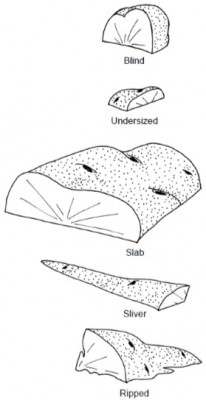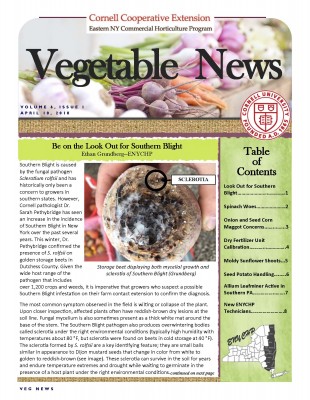Best Practices for Seed Potato Handling
Chuck Bornt, Team Leader, Extension Vegetable Specialist
Eastern New York Commercial Horticulture
I know a few of you have already received your seed potato orders and I think many more will be arriving this week; here are a few thoughts about seed handling and cutting.
First, I understand that when we pay for seed we want to use everyone - but, consider the price of cutting and planting diseased seed? I continue to see more diseases like Silver Scurf (which tends to show up more in storage after harvest) every year. Grade hard and if you see anything that doesn't look right, err on the side of caution and get rid of it.
Cutting seed (information excerpted from University of Maines "Bulletin #2412, Selecting, Cutting and Handling Potato Seed"):
· Disinfect equipment including knives and mechanical cutters before each seed cutting session. Keep knives sharp and straight to prevent ripping the potato surface.
· Warming seed: Potatoes should be warmed to 45—50O Fahrenheit prior to cutting.
· Cut seed tubers into blocky pieces about 1.75 -2.0 ounces in size with at least one eye. Pieces under 1.5 ounces should not be planted. Tubers weighing between 1.5 ounces but under 3.0 ounces should be planted whole. Tubers 3.0—5.0 ounces should be cut into two pieces; 5.0—7.0 ounce tubers should be cut into three pieces.
· Avoid blind pieces (no visible eyes) slab, sliver cuts or ripped pieces as they tend to have less vigor and may result in poor stands.
· Once cut, cool the cut seed to 38 to 40 degrees F and provide good air circulation with relative humidity levels at 85 to 95 percent for 6—10 days to promote healing and prevent dehydration.
· Re-warm seed again for two days before planting to get sprouts growing again and to avoid condensation on the seed.
· Cut potato seed is easily bruised and damaged areas allow decay organisms (on seed or in the soil) to infect the seed piece resulting in slower emergence and less stored energy to promote early growth.
For more information visit the following link to the University of Maine Bulletin 412: https://extension.umaine.edu/p...
 Size of potato piece affects early plant vigor. These are cuts to avoid if possible when cutting potato seed. (source: Bulletin #2412, Selecting, Cutting and Handling Potato Seed, University of Maine)
Size of potato piece affects early plant vigor. These are cuts to avoid if possible when cutting potato seed. (source: Bulletin #2412, Selecting, Cutting and Handling Potato Seed, University of Maine) This article was published in the April 18th 2018 ENYCHP Veg News, to see the full newsletter click: https://rvpadmin.cce.cornell.e...
This article was published in the April 18th 2018 ENYCHP Veg News, to see the full newsletter click: https://rvpadmin.cce.cornell.e...

Upcoming Events
ASL 105 Employee Development and Training
November 17, 2025 : ASL 105: Employment Development and Training
ASL105: Employee Development and Training
Three leadership practices are essential for supervisors: setting clear expectations, employee training and development, and providing performance feedback.
In Employee Development and Training you will learn best practices to plan and conduct training that engages employees, supports retention, and helps ensure great quality work. You will also learn how to create a culture of continuous learning and performance improvement through employee development, coaching, and career planning. This is a 6-week online course, taught in English.
Topics include:
- Planning effective training programs
- Onboarding new employees
- On the job training
- Staff development
- Creating a culture for continuous learning
- Coaching and career planning
Course begins: Wednesday, November 12 Live Zoom discussions: Tuesdays, 3:00 PM - 4:00 PM ET beginning November 18 through December 23.
Registration closes November 17 at 5 PM ET.
Ag Labor Road Show IX
December 1, 2025 : Save the Date! - Ag Labor Roadshow Webinar 1
In addition to the in-person Ag Labor Roadshow program in our region on December 9, two webinars are scheduled for December 1 and December 22. Each webinar will focus on different program content that is different from the in-person sessions. These webinars are an added benefit to program registration.
December 9, 2025 : Save the Date - Ag Labor Road Show In-Person Event (Greenwich, NY)
Greenwich, NY
The Roadshow delivers essential updates on labor law, regulations, and workforce best practices—tailored for farm owners, managers, and ag service providers. Sessions also focus on practical strategies to boost communication, strengthen retention, and build a positive workplace culture.
The in-person session for Eastern NY is December 9 - Elks Lodge, Greenwich, NY - full day in person session
Additional in-person sessions are:
December 10 - Hilton Garden Inn, Watertown, NY, December 17 - Cornell AgriTech, Geneva, NY, December 18 - Genesee Community College, Batavia, NY
December 22, 2025 : Save the Date! - Ag Labor Roadshow Webinar 2
In addition to the in-person Ag Labor Roadshow program in our region on December 9, two webinars are scheduled for December 1 and December 22. Each webinar will focus on different program content that is different from the in-person sessions. These webinars are an added benefit to program registration.
How to Obtain a Pesticide Applicator License
December 17, 2025
Thinking about becoming a certified pesticide applicator in New York, but aren't sure where to start? Join DEC representative Kenneth Klubek for a discussion on who needs to become a certified pesticide applicator, certification types, examination procedures, and recertification. Participants will have ample opportunity to ask questions during the program.












































